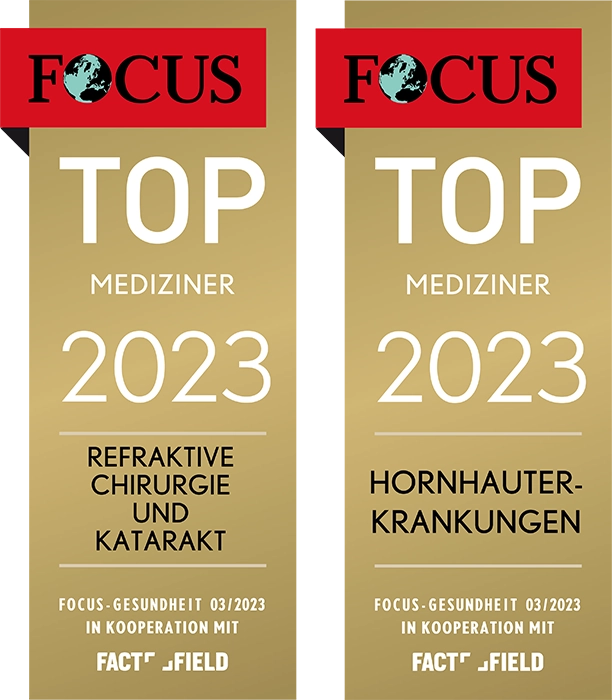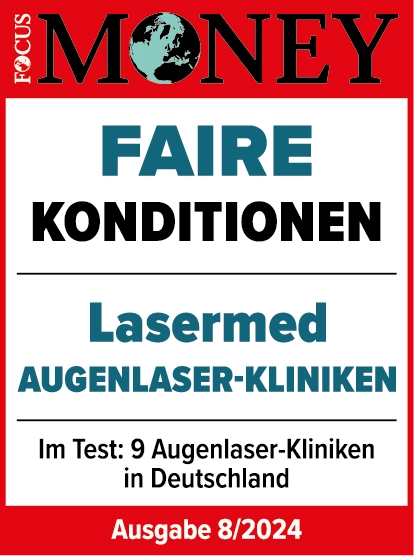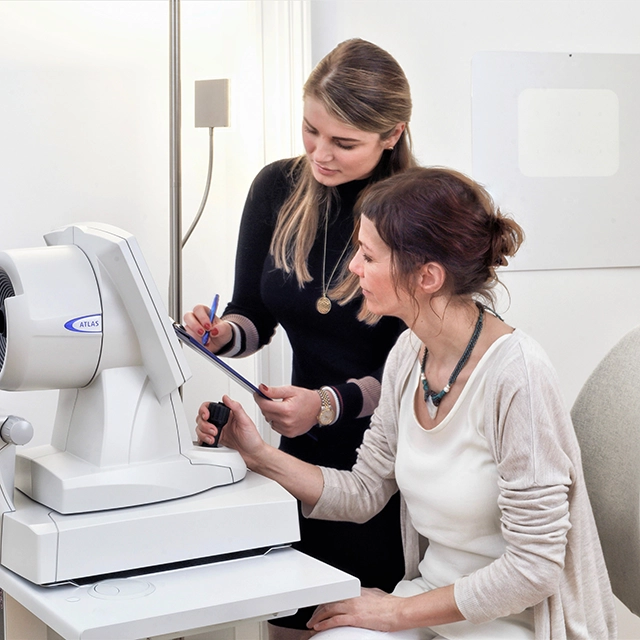
Ihre Brillenfreiheit beginnt mit Augenlasern
Genießen Sie ein neues Lebensgefühl mit Brillenfreiheit und lassen Sie sich von unseren Top Spezialisten für Augenlasern & Linsenbehandlung kostenlos beraten.





Das Wichtigste zum Augenlasern
auf einen Blick in der Übersicht
Augen lasern Methoden Test
Finden Sie jetzt Ihre passende Methode im Quick Check
Ihre individuelle Möglichkeiten für ein Brillenfreies Leben entscheiden sich zu allererst nach Ihrem Lebensalter. Klicken Sie Ihr Alter, um sich über Ihre persönlichen Behandlungsmethoden zu informieren.














Ihre Augenlaser Spezialisten
Wir sind Ihre Experten wenn es um die Korrektur Ihrer individuellen Fehlsichtigkeit geht. Dafür setzen wir auf modernste Augenlaserverfahren, wie ReLEx SMILE Pro, Femto-LASIK, PRK und Presbyond. Zusätzlich bieten wir die Möglichkeit der implantierbaren Kontaktlinsen (ICL) oder des Linsenaustauschs (CLE) an. Neben Sehfehlern wie Kurz- (Myopie) oder Weitsichtigkeit (Hyperopie), behandeln wir ebenso die Korrektur von Hornhautverkrümmungen (Astigmatismus) und Alterssichtigkeit (Presbyopie).
Alle Augenlaser Methoden in der Übersicht
Klicken Sie auf Ihr Alter und lernen Sie alle modernen Möglichkeiten kennen.
Die hier angegebenen Finanzierungen laufen über unsere Zahlungsdienstleister EOS Health AG und medipay GmbH.
*Für die Finanzierungen mit jeweils 24, 36, 48, 60 und 72 Monaten Laufzeit gilt ein effektiver Jahreszins von 9,9 Prozent.

Persönliche Videoberatung
Gerne beraten wir Sie über modernste Augenlaser Methoden bei Lasermed in Berlin, Hamburg und Leipzig. Vereinbaren Sie Ihre persönliche Videoberatung und stellen Sie uns Ihre Fragen über das Augenlasern.
kostenlos und unverbindlich
über PC, Tablet oder Smartphone
ohne Wartezeit und Anfahrt

Unsere Laserverfahren im Vergleich
Anwendung
Vorteile
ReLEx SMILE PRO
Anwendung
Kurzsichtigkeit, Hornhautverkrümmung
Behandlungsdauer: 10 Min
Heilungsdauer: 1 - 2 Tage
sanfteste Methode des Augenlaserns
minimal-invasiver Eingriff
nur 10 Sek. Laserbehandlung pro Auge
Femto-LASIK
Anwendung
Kurzsichtigkeit, Weitsichtigkeit, Hornhautverkrümmung
Behandlungsdauer: 15 Min
Heilungsdauer: 2 - 3 Tage
schnelle Heilung, körpereigenes Pflaster
volle Sehschärfe bereits am nächsten Tag möglich
PRK
Anwendung
Kurzsichtigkeit, Weitsichtigkeit, Hornhautverkrümmung
Behandlungsdauer: 15 Min
Heilungsdauer: 14 Tage
geeignet für dünne Hornhaut
Risikoberufen oder Extrem-Sportler
EVO Visian ICL
Anwendung
Kurzsichtigkeit, Weitsichtigkeit, Hornhautverkrümmung
Behandlungsdauer: 15 Min
Heilungsdauer: 1 - 2 Tage
schnelle Heilung
Korrektur aller Entfernungen möglich
auch bei sehr starker Fehlsichtigkeit
Unsere Bewertungen sprechen für sich
Was unsere Patienten sagen
Ihr brillenfreies Leben beginnt mit jetzt
Sind Sie für das Augenlasern geeignet? Finden Sie es heraus.
Ob sie für eine Augenlaser Behandlung geeignet sind, lässt sich in einem kostenlosen Beratungsgespräch und einer ersten unverbindlichen Untersuchung ermitteln. Relevante Voraussetzungen für eine Augenlaser Behandlung sind im Allgemeinen:

Sie sind mindestens 18 Jahre alt

Stabile Sehstärke in den letzten 1-2 J.

Ausreichende Hornhautdicke

Bestehende Fehlsichtigkeit

Sie haben keine Augenerkrankungen

Sie sind mindestens 18 Jahre alt

Stabile Sehstärke in den letzten 1-2 Jahren

Ausreichende Hornhautdicke

Bestehende Fehlsichtigkeit

Sie haben keine Augenerkrankungen
Was wenn meine Augen nicht für eine Augenlaser Behandlung geeignet sind?
Sollen Ihre Augen nicht für eine Augenlaser Behandlung in Frage kommen, bieten wir Ihnen darüber hinaus unterschiedliche Linsenverfahren wie die EVO Visian ICL an. Gerne beraten wir sie persönlich und individuell zu Ihren Augen.
Finden Sie einen Standort direkt in Ihrer Nähe
Vertrauen Sie Deutschlands Augenspezialisten

Brillenfreies Leben durch
Augenlasern
Fehlsichtigkeiten lassen sich auf klassischem Weg durch Brillen und Kontaktlisen korrigieren oder dauerhaft durch modernes Augenlasern.

Augenheilkunde –
Alles rund ums Auge
Das menschliche Auge ist unser wichtigstes Sinnesorgan. Erst wenn unsere Sehkraft nachlässt, werden wir uns bewusst, wie wichtig gutes Sehen ist.

Kostenlose Augenlaser beratung
Jedes Auge ist einzigartig. Für eine individuelle und bestmögliche Behandlung empfehlen wir Ihnen einen kostenfreien Beratungstermin.
Besuchen Sie unseren Blog rund ums Augenlasern
Als Forschungsexperte und aktives Mitglied in verschiedenen Gremien im Bereich der Augenheilkunde, veröffentlichen wir regelmäßig neue Informationen zum Augenlasern in Berlin, Augenlasern in Hamburg, Augenlasern in Leipzig, Grauer Star Operationen sowie neue Erkenntnisse und allgemeine Informationen zur Augenheilkunde.

LASERMED: Deutschlands Kundenkönige mit Höchstem Kundennutzen
In der Welt der Augenlaser-Kliniken setzen wir Maßstäbe. Wir sind stolz darauf, als einer von "Deutschlands Kundenkönigen" in der aktuellen Studie von ServiceValue in Zusammenarbeit mit der BILD Zeitung ausgezeichnet worden zu sein. Was diese Auszeichnung so besonders...

Lasermed-Ärzte: FOCUS Top-Mediziner in Deutschlands Ärzteliste 2023
Wir sind überglücklich und stolz, Ihnen mitteilen zu können, dass unsere Ärzte von Lasermed in der großen Ärzteliste 2023 des angesehenen Ratgebermagazins FOCUS-Gesundheit ausgezeichnet wurden! Zum 30. Mal präsentiert FOCUS-Gesundheit die Top-Mediziner Deutschlands...

Lasermed Augenzentren MVZ GmbH – Berlins Top-Arbeitgeber 2023!
Wir freuen uns außerordentlich, Ihnen mitteilen zu können, dass die Lasermed Augenzentren MVZ GmbH von kununu, dem führenden Arbeitgeberbewertungsportal, zum besten Arbeitgeber Berlins im Jahr 2023 in der Kategorie Großunternehmen gewählt wurde! Dies ist eine...
Lasermed Kontakt
Sie haben Fragen oder benötigen weitere Informationen
Lasermed Kontakt
Bei Fragen helfen wir Ihnen gerne weiter:
Nutzen Sie einfach unser Kontaktformular.
Sie möchten Kontakt mit uns aufnehmen? Füllen Sie bequem und einfach alle Felder aus und wir melden uns schnellstmöglich persönlich bei Ihnen. Vielen Dank.



